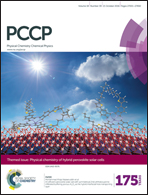Quantum molecular motion in the mixed ion-radical complex, [(H2O)(H2S)]+†
Abstract
The cation dimer of water and hydrogen sulfide, [(H2O)(H2S)]+, serves as a fundamental model for the oxidation chemistry of H2S. The known oxidative metabolism of H2S by biological species in sulfur-rich environments has motivated the study of the inherent properties of this benchmark complex, with possible mechanistic implications for modern water oxidation chemistry. The low-energy isomer of this open-shell ion is a proton-transferred (PT) structure, H3O+⋯SH˙. An alternative PT structure, H3S+⋯OH˙, and a hemibonded (HB) isomer, [H2O·SH2]+, are also stable isomers, placing this complex intermediate to known (H2O)2+ (PT) and (H2S)2+ (HB) limiting regimes. This intermediate character suggested the possibility of unique molecular motion, even in the vibrational ground state. Path integral molecular dynamics and anharmonic vibrational spectroscopy simulations have been performed in this study, in order to understand the inherent quantum molecular motion of this complex. The resulting structural distributions were found to deviate significantly from both classical and harmonic analyses, including the observation of large-amplitude anharmonic motion of the central proton and nearly free rotation of the terminal hydrogens. The predicted vibrational spectra are particularly unique and suggest characteristic signatures of the strong electronic interactions and anharmonic vibrational mode couplings in this radical cation.
![Graphical abstract: Quantum molecular motion in the mixed ion-radical complex, [(H2O)(H2S)]+](/en/Image/Get?imageInfo.ImageType=GA&imageInfo.ImageIdentifier.ManuscriptID=C6CP05299A&imageInfo.ImageIdentifier.Year=2016)
- This article is part of the themed collection: PCCP Emerging Investigator Lectureship Award Winners

 Please wait while we load your content...
Please wait while we load your content...